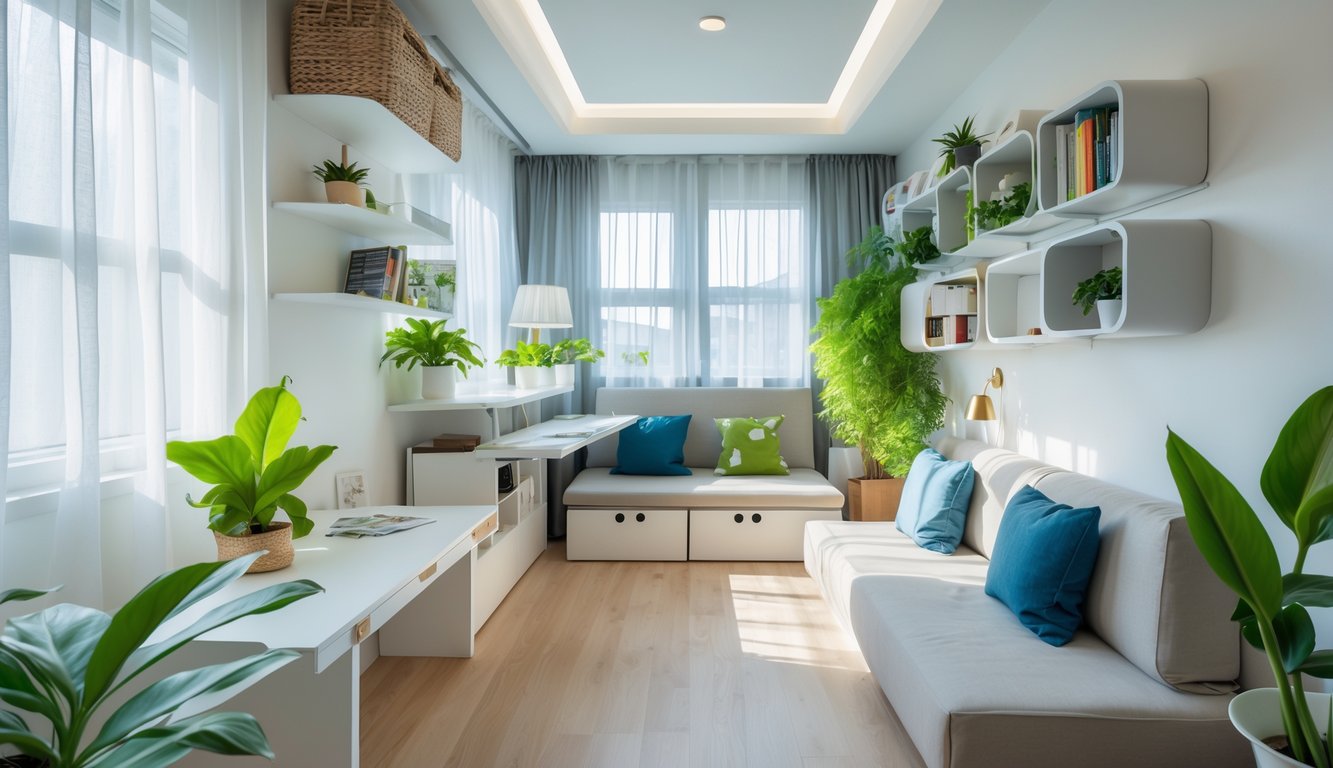
Why is my closet basically a landfill, no matter how many times I dump stuff at Goodwill? I swear I declutter, but then I go looking for a charger and just find a tangle of mystery cords and a single glove. Built-in storage, floating shelves jammed into that useless corner—honestly, they do a lot more than just hide my mess. Suddenly it looks like I hired someone who charges $300/hour to make my apartment look “intentional.” I read somewhere (Family Handyman, I think?) that reworking attic space is supposedly 2.6x more useful for storage than just buying more baskets. Is that number real? No idea, but sure, let’s believe it.
Tiny home influencers have me rethinking everything. I saw this one photo by Max Vakhtbovycn on Pexels—a rolling rack under a loft bed. Now every time I look at my own bed, I wonder why I’m still cramming stuff into those sad blue IKEA bins. Designers keep saying a mirror or knocking out a wall will “open the space.” I want to believe them, but last time I tried, I hit a pipe, so… yeah. Apparently, compact living isn’t about giving up stuff, just pretending the chaos is “design.”
Maybe square footage isn’t even the issue. Layering textures is a thing—velvet pillows on a futon? Weird flex, but it does look expensive. Modular furniture is supposed to be magic, but I still remember getting my “full-size” couch wedged in the stairwell for almost an hour. Maximizing small spaces isn’t some minimalist fantasy—it’s just survival when the junk drawer turns into a junk closet.
Embracing Minimalism in Small Spaces

I’m haunted by my last closet purge—how did I end up with seven nearly identical black tees? More stuff is not better in a tiny apartment. White walls don’t help if you’re tripping over coffee tables and dodging “statement” rugs. I’m not Marie Kondo, but if having less means fewer bruised shins and less anxiety, I’ll try almost anything. Except glass chairs. Never again.
Benefits of Minimalist Design
Nobody warned me that minimalism might actually help with clutter. Architectural Digest said something like, “Minimalism is about quality over quantity,” which I always thought meant gold-plated lamps and overpriced vases. Turns out, having less stuff means you can breathe—and maybe even roll out a yoga mat.
Cutting furniture down turned my 400-square-foot rental from “panic room” to “livable.” Some UCLA study (look it up, “UCLA Center on Everyday Lives of Families”) claims less visual mess = lower stress hormones. I ditched the pile of remote controls for an all-in-one hub. Life got quieter.
Tossing out knick-knacks (does anyone know what to do with souvenir spoons?) felt good. Cleaning is way faster. Are minimalist studios sterile? Sometimes, yeah. But honestly, I’d rather risk that than dig through a shoe mountain to find my keys at 7am.
Choosing a Cohesive Color Palette
If you’ve ever stood in a paint aisle arguing with yourself about “eggshell” or “cloud white,” you know the pain. The only thing that works in a small space: neutrals and soft earth tones. It doesn’t have to be all beige sadness; one bold pillow can make the room feel less like a waiting room.
Designers push the “2–3 colors only” rule and, annoyingly, they’re right. Last time I had a color consult, they showed me Sherwin Williams’ trending neutrals. Beige and taupe, apparently, are it for 2024. Is it exciting? Not really. Does it actually make rooms look bigger? Yep.
I tried sneaking in a lime green beanbag and it looked like a radioactive frog. Lesson learned: keeping everything in the same palette makes it look like you planned it. Accent colors are fine, just… don’t go wild.
Limiting Patterns for Calmness
By 8pm, if I see another clashing geometric print, I’ll lose it. Too many patterns = instant chaos. Some Fraunhofer Institute study (2022?) said eye fatigue goes up with high-contrast patterns. Wish I’d read that before I bought zebra sheets.
Scatter patterns everywhere and your apartment looks like a circus. My friend went all plain, but honestly, one patterned thing—a striped runner, for example—is enough. It catches the eye without turning your space into a headache.
If you stick to patterns in the same color family, your brain doesn’t freak out. Subtle herringbone wallpaper, barely off-white, is almost invisible but somehow makes the room look finished. And it hides scuffs, which, honestly, is the real win.
Smart Storage Solutions for Compact Living
Clutter just sneaks up on you. I hide luggage under the bed, coats behind doors, and still run out of space. Cabinets help, but if storage isn’t both above and below eye level, it just eats up the room. Every apartment I’ve lived in turns into a game of “how high can I stack boxes before the ceiling fan is at risk?”
Hidden Storage Ideas
There’s a drawer under your kitchen cabinets—pull off the kickboard and, surprise, it’s there. I toss dog leashes and extension cords down there so I’m not hunting at the last minute. Beds with built-in drawers are everywhere on Pinterest, but my studio only fit a futon, so I built sliding bins for the closet. Socks still escaped. My neighbor, who’s read every storage article since the ‘80s, swears by ottomans with removable tops. Consumer Reports tested one at 52 pounds of storage. I just use my entry bench to hide jackets when people come over.
Utilizing Vertical Storage
If there’s three feet between the fridge and ceiling, why is it empty? I stacked mismatched IKEA Kallax cubes up the wall—they’re wobbly unless you anchor them, but whatever. Shoes now hang from ceiling hooks. A contractor told me pull-down racks are the secret; you see everything at a glance. Pegboards, wire baskets, those TikTok spice shelves—they’re everywhere in my place. Vertical storage means I clear out junk, except for the mugs people keep gifting me.
Creative Built-In Storage
Loose shelves are a pain, so I finally hired a carpenter. She built a window bench that swallows all my board games. Built-in wardrobes go to the ceiling, but the top shelf just becomes a graveyard for hats and Christmas stuff. Sliding-door bookcases let me hide every magazine I’ve hoarded since 2010. An interior designer I trust says rehabbing alcoves can add 8% more usable space. My cousin even built her cat’s litter box into the closet wall—nobody notices except the cat.
Floating Shelves for Small Homes
Floating shelves are magic. I bought some adjustable ones at the hardware store—Target has them too. My neighbor needed a level to hang hers; I just eyeballed it and hoped for the best. Wall anchors are a must (learned after smashing two mugs and nearly crying). Over the toilet, above the kitchen counter, behind the bed—even in weird corners, if you’re patient with brackets. My favorite shelf is above the washer—holds detergent and stray socks. Mixing plants and books makes it look like I have a plan. If a shelf sags, just saw it shorter. The only thing worse than a droopy shelf is realizing you left it behind when you move.



